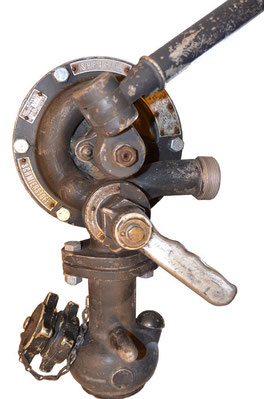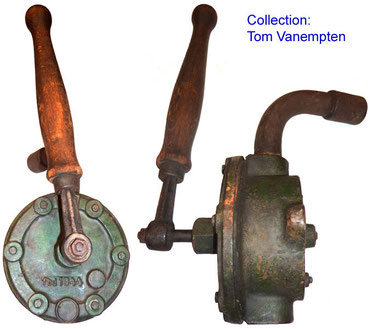The German Luftwaffe used two standard hand pump types to pump oil or fuel into their aircraft by
hand.
For fuel it was the Kraftstoffhandpumpe (KHP 4) and for lubricating oil they had the Schmierstoffhandpumpe (SHP 4).

Tags on the SHP4 pump with purpose liquid, manufacturer, FL code number and instructions for liquid flow directions. There also is a tag with a double-sided arrow with R and V at the end
which means Rückwärts-/Vorwärtsförderung (pumping direction).
Tags on the early war version of the KHP4 pump with purpose liquid, manufacturer, FL code number.
Tags on the late war version of the KHP4 pump with purpose liquid, (ezd for Allweiler Radolfzell), FL code number.
Beside the pumps produced by Allweiler, lots of other equipment was needed to fill the liquids into the planes. Special connections to the fuel tanks, hoses, filters and spouts were needed. These parts were produced by the Deutsche Benzinuhren Gesellschaft (DBU) in Berlin.



Hand operated oil-trailer ( Öltankwagen mit Handbetrieb ) with a content of 300
litres. This trailer was equipped with two Allweiler hand pumps
( SHP 4 ) with filters for lubricating oil. Each pump had its own intended use. One was used to fill the trailer tank itself and the other one was used to fill the aircraft. The oil was heated by
the trailer with steam or by electric heating which took twice as long as the steam heating.
Also the German Army used hand pumps during WWII.
If not mounted on a vehicle (loaded with several drums connected with each other) the main difference to the Luftwaffe pump models was the size. While the Luftwaffe used the size 4, the Heer had smaller size 2 pumps as a standard model. Most of these pumps also with missing screw in plug to the drums.
The Heer units had to move regularly during operations with all their equipment. That is the reason for lighter and not so complicated equipment as the Luftwaffe used on their static airfields. In addition the Luftwaffe had specially designed trailers for the heavy equipment concerning all liquids to be delivered to the aircraft. They were usually towed by hand or horse.
Prize lists of the years 1938 and 1941 show the increase of the prices and the price structure of all the spare parts used with the hand pumps.
The German Army mostly used civilian types of pumps. There was no difference in the workmanship to pumps produced for the military. Of course military pumps were marked in another way.
Thank you for reading this chapter. If you have one or more WWII hand pumps in your collection, or wartime pictures of them in use, feel free to contact me via the form below. Every message is welcome!




























